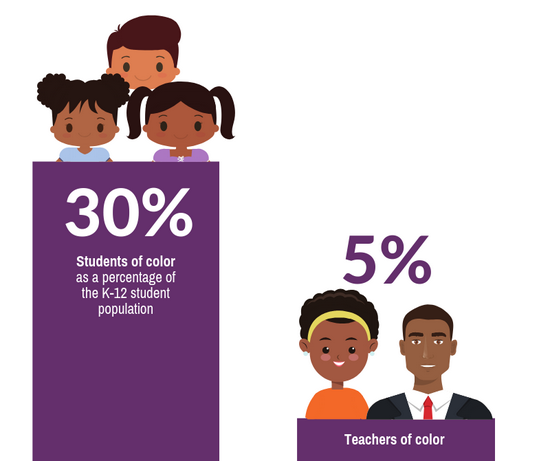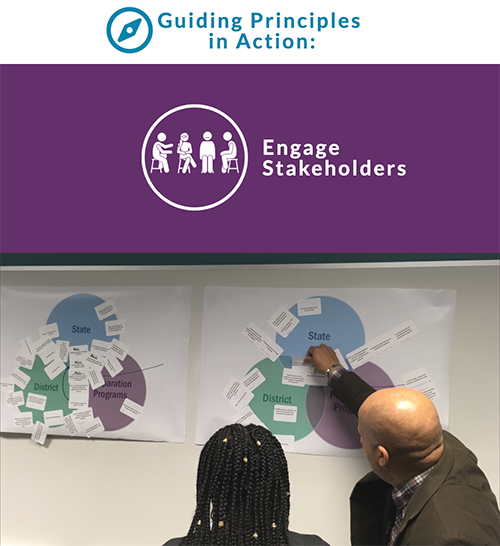Ohio: Diversifying the Educator Workforce
A stakeholder-driven, evidence-based plan to transform the diversity of the educator workforce.
Featured Tool
Diversifying the Educator Workforce: A Data Tool for Practitioners
Use this free, user-friendly data tool to identify, visualize, and target diversity gaps across the entire educator career continuum.
Client
Ohio Department of Education (ODE)
Project
Facilitate a 40-member stakeholder group to select and prioritize evidence-based strategies to improve educator workforce diversity.
Outcome
Stakeholder and data-driven action plan to diversify the educator workforce
Team
Cheryl Krohn, ODE Lead
Etai Mizrav, GTL Project Lead
Bersheril Bailey, GLCC Support
The Challenge
Ohio knew it was facing significant educator diversity gaps. While its student population is increasingly diverse, with students of color making up 30% of all K-12 students in Ohio, its educators are predominantly white: educators of color make up only 5% of the educator workforce.
The Opportunity
Focused on closing that gap, Ohio committed in its Every Student Succeeds Act (ESSA) plan to use data, engage stakeholders, and identify potential opportunities and partnerships for recruiting and retaining a diverse educator workforce.

The Approach
In collaboration with the Ohio Department of Education (ODE) and the Great Lakes Comprehensive Center (GLCC), the Center on Great Teachers and Leaders (GTL Center) developed a four-step process with a suite of supporting tools and resources that allow states to create a locally driven, evidence-based action plan for improving the diversity of their educator workforce.
Step 1. Data Analysis
Use the GTL Center's Insights on Diversifying the Educator Workforce Data Tool to measure, analyze, and visualize existing educator workforce diversity gaps across the educator career continuum and at the state, district, school, and Educator Preparation Program (EPP) levels.
Step 2. Root Cause Analysis
Use a modified-version of the GTL Center's Root Cause Analysis Workbook to consult with educators and other stakeholders to identify the underlying root causes for identified gaps.
Step 3. Evidence-based Strategy Selection
Link identified root causes with evidence-based, high-impact strategies like mentoring and induction and teacher leadership models and select a timeline for implementation.
Step 4. Implementation, Monitoring, and Continuous Improvement
Explore the GTL Center's Evidence-Based Strategies or action planning and implementation tools for high-leverage strategies. Monitor intended and unintended consequences to ensure that the strategies are effective in accomplishing the identified goals.
Project Outcomes
To date, the working group has completed steps 1-3 of the process and is finalizing a document outlining the group’s recommendations and associated strategies. The GTL Center’s lead for the project, Etai Mizrav, notes that the focus for the project is notes that the focus for the project is not to create an ambitious, comprehensive plan that sits on a shelf but rather an actionable plan that can achieve real change:
“Too often, states produce compelling, well-designed, comprehensive plans that simply end up having limited impact in real classrooms. In this project we are seeing different kind of leadership from Ohio.
From the very beginning, the state has shown genuine readiness and willingness to drive change and improve outcomes for all students. ODE was never afraid to go deep and tough on those issues that can be contentious and engage in difficult, but necessary, conversations that can result in actual impact.
Our goal with this project is to produce a real action plan: a technical, practical document outlining those strategies that all stakeholders are ready to commit to and that would make a real difference for students who are currently in the system, one that includes concrete steps, budgets, and real funding streams associated each strategy.”
Etai Mizrav,
Center on Great Teachers and Leaders,
Project Lead
Guiding Principles in Action: Putting Stakeholders in the Driver's Seat
In November 2018, ODE partnered with the Ohio Department of Higher Education (ODHE) to convene a thoughtfully selected, diverse group of 40 stakeholders including district leaders, principals, teachers, students, HR directors, community organizations, deans of educator preparation programs and others to engage in the four-step process. According to Cheryl Krohn, Center Strategic Administrator at ODE and the agency lead for the project, making sure the right people were at the table was crucial to the project:
“It's a lot of work to get the right people in the room. The GTL Center helped me look through my stakeholder list, make sure I had the right people in the room [and ensure the group] was diverse in different ways. This isn't necessarily an easy topic either, so it's important to have the right partners to have these conversations.”
As part of priming stakeholders to engage in future partnerships, ODE made building-up the capacity of local actors a core goal for the project. Krohn notes that “the GTL Center made sure we had the resources and tools necessary so that local stakeholders could also go back to their local entity and do the same work, look at their own data and do their own root cause analysis and think of their own strategies to tackle the work.”
Client Perspective
“The GTL Center helped us pick evidence-based strategies that we felt were right for Ohio. [They] guided [the process] with evidence, with our participants really reflecting on what they wanted and what our problems were, and then vetting strategies. That's why I liked working with the GTL Center, they allowed that space. They didn't control, they allowed it to flow, but it was structured to happen that way. By the end, people were voting and prioritizing the recommendations.”
Center Strategic Administrator,
Ohio Department of Education






